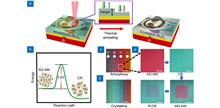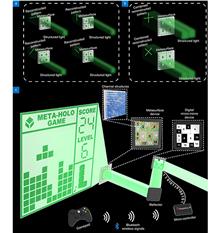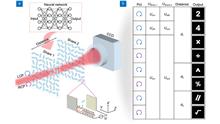 View fulltext
View fulltext
High-resolution multi-color printing relies upon pixelated optical nanostructures, which is crucial to promote color display by producing nonbleaching colors, yet requires simplicity in fabrication and dynamic switching. Antimony trisulfide (Sb2S3) is a newly rising chalcogenide material that possesses prompt and significant transition of its optical characteristics in the visible region between amorphous and crystalline phases, which holds the key to color-varying devices. Herein, we proposed a dynamically switchable color printing method using Sb2S3-based stepwise pixelated Fabry-Pérot (FP) cavities with various cavity lengths. The device was fabricated by employing a direct laser patterning that is a less time-consuming, more approachable, and low-cost technique. As switching the state of Sb2S3 between amorphous and crystalline, the multi-color of stepwise pixelated FP cavities can be actively changed. The color variation is due to the profound change in the refractive index of Sb2S3 over the visible spectrum during its phase transition. Moreover, we directly fabricated sub-50 nm nano-grating on ultrathin Sb2S3 laminate via microsphere 800-nm femtosecond laser irradiation in far field. The minimum feature size can be further decreased down to ~45 nm (λ/17) by varying the thickness of Sb2S3 film. Ultrafast switchable Sb2S3 photonic devices can take one step toward the next generation of inkless erasable papers or displays and enable information encryption, camouflaging surfaces, anticounterfeiting, etc. Importantly, our work explores the prospects of rapid and rewritable fabrication of periodic structures with nano-scale resolution and can serve as a guideline for further development of chalcogenide-based photonics components.
Recently, deep learning has yielded transformative success across optics and photonics, especially in optical metrology. Deep neural networks (DNNs) with a fully convolutional architecture (e.g., U-Net and its derivatives) have been widely implemented in an end-to-end manner to accomplish various optical metrology tasks, such as fringe denoising, phase unwrapping, and fringe analysis. However, the task of training a DNN to accurately identify an image-to-image transform from massive input and output data pairs seems at best na?ve, as the physical laws governing the image formation or other domain expertise pertaining to the measurement have not yet been fully exploited in current deep learning practice. To this end, we introduce a physics-informed deep learning method for fringe pattern analysis (PI-FPA) to overcome this limit by integrating a lightweight DNN with a learning-enhanced Fourier transform profilometry (LeFTP) module. By parameterizing conventional phase retrieval methods, the LeFTP module embeds the prior knowledge in the network structure and the loss function to directly provide reliable phase results for new types of samples, while circumventing the requirement of collecting a large amount of high-quality data in supervised learning methods. Guided by the initial phase from LeFTP, the phase recovery ability of the lightweight DNN is enhanced to further improve the phase accuracy at a low computational cost compared with existing end-to-end networks. Experimental results demonstrate that PI-FPA enables more accurate and computationally efficient single-shot phase retrieval, exhibiting its excellent generalization to various unseen objects during training. The proposed PI-FPA presents that challenging issues in optical metrology can be potentially overcome through the synergy of physics-priors-based traditional tools and data-driven learning approaches, opening new avenues to achieve fast and accurate single-shot 3D imaging.
Interactive holography offers unmatched levels of immersion and user engagement in the field of future display. Despite of the substantial progress has been made in dynamic meta-holography, the realization of real-time, highly smooth interactive holography remains a significant challenge due to the computational and display frame rate limitations. In this study, we introduced a dynamic interactive bitwise meta-holography with ultra-high computational and display frame rates. To our knowledge, this is the first reported practical dynamic interactive metasurface holographic system. We spatially divided the metasurface device into multiple distinct channels, each projecting a reconstructed sub-pattern. The switching states of these channels were mapped to bitwise operations on a set of bit values, which avoids complex hologram computations, enabling an ultra-high computational frame rate. Our approach achieves a computational frame rate of 800 kHz and a display frame rate of 23 kHz on a low-power Raspberry Pi computational platform. According to this methodology, we demonstrated an interactive dynamic holographic Tetris game system that allows interactive gameplay, color display, and on-the-fly hologram creation. Our technology presents an inspiration for advanced dynamic meta-holography, which is promising for a broad range of applications including advanced human-computer interaction, real-time 3D visualization, and next-generation virtual and augmented reality systems.
Secret sharing is a promising technology for information encryption by splitting the secret information into different shares. However, the traditional scheme suffers from information leakage in decryption process since the amount of available information channels is limited. Herein, we propose and demonstrate an optical secret sharing framework based on the multi-dimensional multiplexing liquid crystal (LC) holograms. The LC holograms are used as spatially separated shares to carry secret images. The polarization of the incident light and the distance between different shares are served as secret keys, which can significantly improve the information security and capacity. Besides, the decryption condition is also restricted by the applied external voltage due to the variant diffraction efficiency, which further increases the information security. In implementation, an artificial neural network (ANN) model is developed to carefully design the phase distribution of each LC hologram. With the advantage of high security, high capacity and simple configuration, our optical secret sharing framework has great potentials in optical encryption and dynamic holographic display.
Advancements are reported in computer-generated holography proofing RGB 4K display through a new strategy based on diffraction model-driven deep networks. In the new 4K-DMDNet, the network is not a “black box” anymore. Rather, the input-output relation must obey to the physics of wavefront propagation, which is embedded here as a constraint. Thus, a labelled dataset is not required, and the model shows superior generalization capabilities with respect to data-driven approaches. The method is promising for the new generation of RGB 4K holographic display, as well as augmented and virtual reality systems.












